| dc.contributor.author | Herren, Blake | |
| dc.contributor.author | Charara, Mohammad | |
| dc.contributor.author | Saha, Mrinal C. | |
| dc.contributor.author | Altan, M. Cengiz | |
| dc.contributor.author | Liu, Yingtao | |
| dc.date.accessioned | 2020-02-24T18:48:21Z | |
| dc.date.available | 2020-02-24T18:48:21Z | |
| dc.date.issued | 2020-01-29 | |
| dc.identifier.citation | Herren, Blake; Charara, Mohammad; Saha, Mrinal C.; Altan, M. Cengiz; Liu, Yingtao. 2020. "Rapid Microwave Polymerization of Porous Nanocomposites with Piezoresistive Sensing Function." Nanomaterials 10, no. 2: 233. https://doi.org/10.3390/nano10020233 | en_US |
| dc.identifier.uri | https://hdl.handle.net/11244/323767 | |
| dc.description.abstract | In this paper, polydimethylsiloxane (PDMS) and multi-walled carbon nanotube (MWCNT) nanocomposites with piezoresistive sensing function were fabricated using microwave irradiation. The effects of precuring time on the mechanical and electrical properties of nanocomposites were investigated. The increased viscosity and possible nanofiller re-agglomeration during the precuring process caused decreased microwave absorption, resulting in extended curing times, and decreased porosity and electrical conductivity in the cured nanocomposites. The porosity generated during the microwave-curing process was investigated with a scanning electron microscope (SEM) and density measurements. Increased loadings of MWCNTs resulted in shortened curing times and an increased number of small well-dispersed closed-cell pores. The mechanical properties of the synthesized nanocomposites including stress–strain behaviors and Young’s Modulus were examined. Experimental results demonstrated that the synthesized nanocomposites with 2.5 wt. % MWCNTs achieved the highest piezoresistive sensitivity with an average gauge factor of 7.9 at 10% applied strain. The piezoresistive responses of these nanocomposites were characterized under compressive loads at various maximum strains, loading rates, and under viscoelastic stress relaxation conditions. The 2.5 wt. % nanocomposite was successfully used in an application as a skin-attachable compression sensor for human motion detection including squeezing a golf ball. | en_US |
| dc.description.sponsorship | This research received no external funding and The APC was funded by University Libraries Open
Access fund. Open Access fees paid for in whole or in part by the University of Oklahoma Libraries. | en_US |
| dc.language | en_US | en_US |
| dc.rights | Attribution 4.0 International | * |
| dc.rights.uri | https://creativecommons.org/licenses/by/4.0/ | * |
| dc.subject | microwave irradiation | en_US |
| dc.subject | nanocomposite | en_US |
| dc.subject | elastomer | en_US |
| dc.subject | polydimethylsiloxane | en_US |
| dc.subject | carbon nanotubes | en_US |
| dc.subject | piezoresistive sensor | en_US |
| dc.subject | microstructures | en_US |
| dc.title | Rapid Microwave Polymerization of Porous Nanocomposites with Piezoresistive Sensing Function | en_US |
| dc.type | Article | en_US |
| dc.description.peerreview | Yes | en_US |
| dc.identifier.doi | 10.3390/nano10020233 | en_US |
| ou.group | Gallogly College of Engineering::School of Aerospace and Mechanical Engineering | en_US |

